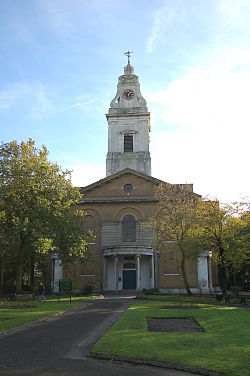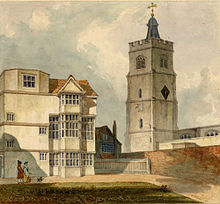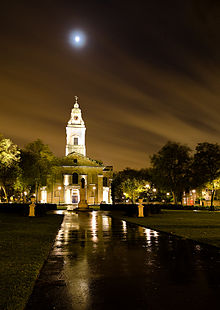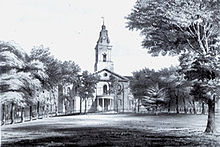- Church of St John-at-Hackney
-
Church of St John-at-Hackney 
Portico and tower of the Church of St John-at-HackneyCountry United Kingdom Denomination Church of England Website St John-at-Hackney Architecture Architect(s) James Spiller Administration Parish Hackney Clergy Archdeacon Lyle Dennen Rector Rob Wickham The Church of St John at Hackney is situated in the London Borough of Hackney. It was built in 1792, in an open field, north east of Hackney's medieval parish church, of which only St Augustine's Tower remains. Separated by the southern extension of Lower Clapton Road, it looks north to the late Georgian Clapton Square.
Contents
History
The Church of St John-at-Hackney was designed by James Spiller, and built in 1792. At this time, Hackney Parish was the largest in Middlesex. The vast, classical style building, on a Greek cross plan, can hold 2,000 people.
The former churchyard is now a complex of gardens that was awarded Heritage Green Site Status in 2008. The building is Grade II* listed and houses monuments dating from Tudor times – transferred from the former church – and other more recent memorials.
St Augustine's Church
It is possible that a church stood here, in this small but wealthy village north of the City of London, before the Norman Conquest, but no records survive of any building before 1275 and any prior church would have been a part of the parish of Stepney. From the 14th century the church was dedicated to St Augustine of Hippo until, after 1660, it was rededicated to St John the Baptist, later becoming more commonly known as St John-at-Hackney.[1]
In the 13th century, much of the land around Hackney formed part of the possessions of the Knights Templars. When the order was disbanded, their possessions were passed to the Order of St John of Jerusalem, who had a mansion on Church Street. The Order of St John began with the First Crusade to the Holy Land in 1095. When the Crusaders captured Jerusalem and founded a hospice. In 1113, the Pope recognised it as an independent religious order of monks and nuns, The Order of St John, whose special task was to care for the sick. At the dissolution, the lands passed to the Crown, and were parcelled amongst Tudor nobles, including Thomas Sutton and Ralph Sadleir.[1]
Growing congregation
Hackney's proximity to the City of London and the court made it popular with courtiers, city merchants and businessmen, and for an increasing number of private schools which were established in some of the older houses. By 1789, the church capacity, with the addition of numerous galleries, had reached 1,000. This however was not enough.[1]
 c.1750 View of St Augustine's Tower, showing the (then) adjacent Black and White House
c.1750 View of St Augustine's Tower, showing the (then) adjacent Black and White House
In 1779, a surveyor, Richard Jupp proposed a rebuilding to increase the capacity to 1,480, but no action was taken. By 1788, a committee found that the population of the parish had increased so much that the church should seek to seat 3,000. The appointed architect, William Blackburn, firmly rejected the idea of building on the old site, advising that a budget of £15,000 be created to buy land on which to construct a new church.[1]
April 1789 the committee put the matter to a parochial vote. winning their case by 313 votes to 70, and a Bill was put to the House of Commons. Opponents of the proposal undertook yet another survey with a view to rebuild on the old site. Finally, a compromise was reached; the Bill became an Act empowering the Trustees to acquire, for £875, Church Field which lay to the north-east of the existing churchyard. The existing tenants, a butcher and corn chandler, were given three months to leave.[1]
New church
A new church, tower and vestry room would be built within three years of laying the foundation, and then the old church demolished. In the event the initial estimates of costs were badly out and two further Acts had to be passed through Parliament to allow extra money to be raised.
William Blackburn died suddenly in November 1790; a month later James Spiller, influenced by and a friend of John Soane, was chosen from six architect candidates. Hackney church was his largest project to date and remained his magnum opus. Believing that a building seating 3,000 would have poor acoustics, he persuaded the Trustees to allow him to reduce the capacity to 2,000, but remained convinced that the acoustics would not be good unless the church was full.
Work began in spring 1792, and the main structure took more than two years to complete. On 15 July 1797, the church was consecrated, with a wooden box-like structure where the tower would later be added.
Loddiges' family vault in St John's Church Gardens
Harry Sedgwick, a trustee, oversaw a subscription for planting the churchyard. 129 subscriptions enabled nearly 200 elms and horse chestnuts to be planted in avenues. Sedgwick was later buried in the churchyard; and his planting achievement is commemorated on his tomb. Sedgwick lost his only son in action in the Napoleonic War, he has an elaborate memorial inside the church.
In March 1798, the body of the old church was demolished and several of the tombs removed to the new church. The tower remained - left intact to hold the bells, as funds did not run to building a tower on the new church. In 1814, the tower was added to the church, and in 1816, a stained glass east window was installed behind the altar.
The old tower of St Augustine's Church remains standing to this day and plays a symbolic and ceremonial role in Hackney: It has adorned the masthead of the Hackney Gazette since its foundation in 1864 and is incorporated in the coat of arms of the London Borough of Hackney.
Major fire damage
Beaufort tomb in St John's Church Gardens
On 18 May 1955, a fire started in the church roof, destroying the roof, many of the pews and the 1799 organ, by George Pike England. During the ensuing major reconstruction work there was some reordering of the interior.
A replacement three manual Mander organ came from All Saint's Ennismore Gardens, Kensington; altar hangings designed for the coronation of Queen Elizabeth II at Westminster Abbey were donated; and the east window replaced by a new one designed by Christopher Webb. The new church was reconsecrated on 24 June 1958 (St John's Day).
Repair work was carried out on the roof, in 2004, funded by English Heritage; and an electrical fire in January 2006, caused minor damage to the church – but the organ still needs to be checked for smoke damage. The fabric of the 200–year old church still requires major maintenance, and the parish has prepared an action plan to raise money and proceed with refurbishment and adaptation of the building to the modern needs of the parish.
At the Church fete on 5 July 2008, the church and its churchyard were re-dedicated by the Archdeacon of Hackney, in celebration of the fiftieth anniversary of the reconstruction and the major works undertaken to regenerate the church gardens over the previous year. St John's Church Gardens, around the tower and church were awarded both a Green Flag award, and Green Flag Heritage status, in 2008.
Hunter tomb in St John's Church Gardens
Current clergy
Fr Rob Wickham was inducted as Rector of Hackney in March 2007.
Dr Lincoln Harvey and Sebastian Ejiaku are both assistant clergy. Fr Chris Ferris is Associate Rector and Chaplain to the Urswick School. Emily Ovenden is the Parish Administrator.
Babs Scott Wollaston is the Reader Emeritus.St John at Hackney is now overseeing the St John at Hackney project, launched in June 2008. This is a five year plan to make the building fit for purpose, along with several community ministry projects.
Other burials
- David Dolben, a Welsh Bishop of Bangor - where his monument, containing a half-length statue and a eulogistic description of him, still remains.
- Timothy Hall (bishop)
References
- Guide to the Local Administrative Units of England, Vol.1, Frederic Youngs, London, 1979
- St John-at-Hackney
- www.stjohnsmusic.co.uk
External links
The nearest London Overground station is Hackney Central Coordinates: 51°32′57″N 0°03′12″W / 51.549224°N 0.053360°W
Categories:- Church of England churches in London
- Grade II* listed churches in London
- Churches in Hackney
- 1792 architecture
Wikimedia Foundation. 2010.





